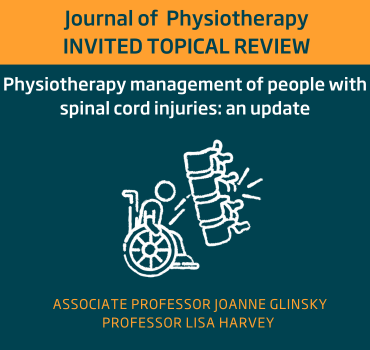Physiotherapy management of people with spinal cord injuries-update
Physiotherapy management of people with spinal cord injuries: an update
Spinal cord injury (SCI) has widespread consequences on physical and psychosocial health, participation and bodily function such as bladder and bowel function, and is associated with many secondary complications. Physiotherapists play an essential role within the multidisciplinary team for people with SCI at all stages from the acute setting through rehabilitation and into the community.
The global incidence of traumatic SCI is estimated to be 10 cases per 100,000 people, but this varies between high, middle and low-income countries, occurring mainly in adolescents, younger adults and increasingly in older adults. SCI are classified as complete or incomplete and given a neurological level according to the International Standards for the Neurological Classification of SCI, which provides information for the clinician about the extent of paralysis and potential outcomes with rehabilitation.
Physiotherapists commonly treat physical impairments in people with SCI including weakness, poor respiratory function, decreased joint mobility, poor motor skills and decreased cardiorespiratory fitness. Other interventions manage pain, spasticity, swelling and more.
In their Journal of Physiotherapy Invited Topical Review, Joanne Glinsky and Lisa Harvey outline the recent clinical practice guidelines—the Australia and New Zealand Clinical Guidelines for the physiotherapy management of people with SCI (SCIPT CPG)—developed by their team in conjunction with a panel of Australian and New Zealand physiotherapists. The panel completed a comprehensive review of the evidence for 100 PICO (participant, intervention, comparison, outcome) questions using the Evidence to Decision Framework. A total of 14 ‘evidence recommendations’ and more than 80 ‘consensus-based opinion statements’ were included in the resulting guidelines, expressed as strong or weak, and for or against, each intervention.
The review focuses on some of the key consensus-based opinion statements and evidence recommendations from the SCIPT CPG, covering the most-administered physiotherapy interventions and the evidence supporting these. Interventions discussed include strength training for muscle weakness in non-paralysed and partially paralysed muscles, respiratory treatments for improving lung volumes and secretion clearance, contracture management, motor skill training, cardiorespiratory fitness training, pain management, spasticity management and interventions for swelling.
The authors also address the need for more high quality randomised controlled trials to examine the effectiveness of physiotherapy interventions, noting that the low number of evidence recommendations were due to a paucity of relevant high quality RCTs. They suggest that more RCTs need to be conducted to evaluate commonly used interventions in current clinical practice, instead of only focusing on emerging therapies.
For more information and to read the entire article, see Invited Topical Review.

This blog is a Physiotherapy Research Foundation (PRF) initiative.
Associate Professor Joanne Glinsky is a physiotherapist and researcher at the John Walsh Centre for Rehabilitation Research, an interdisciplinary centre of the Sydney School of Health Sciences at the University of Sydney, and the Kolling Institute of Medical Research at Royal North Shore Hospital. Joanne has a strong interest in physiotherapy management of people with neurological conditions and has worked for 20 years as a clinician and researcher in this field.
Professor Lisa Harvey is a physiotherapist and a researcher at the John Walsh Centre for Rehabilitation Research with over 20 years’ experience in the area of spinal cord injuries. Lisa is primarily interested in investigating the effectiveness of different physiotherapy interventions for people with spinal cord injury.
